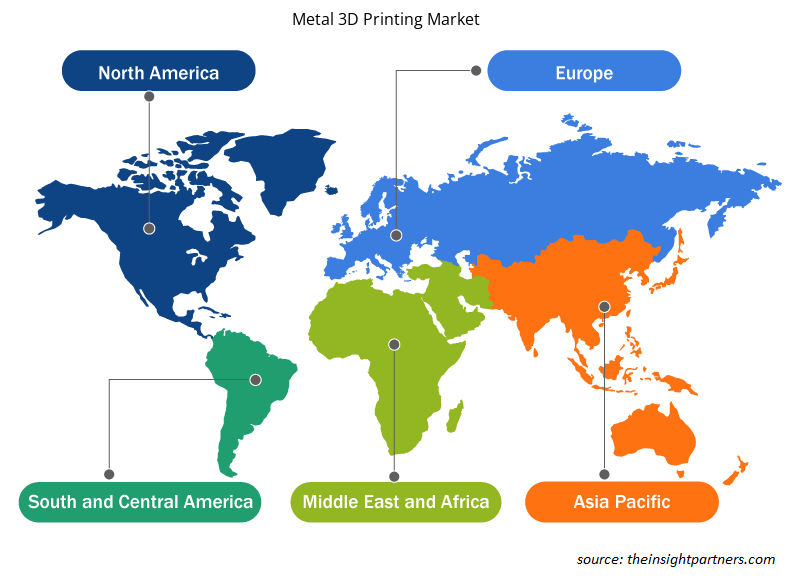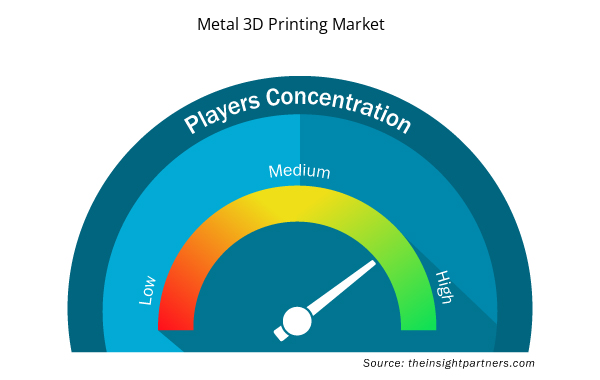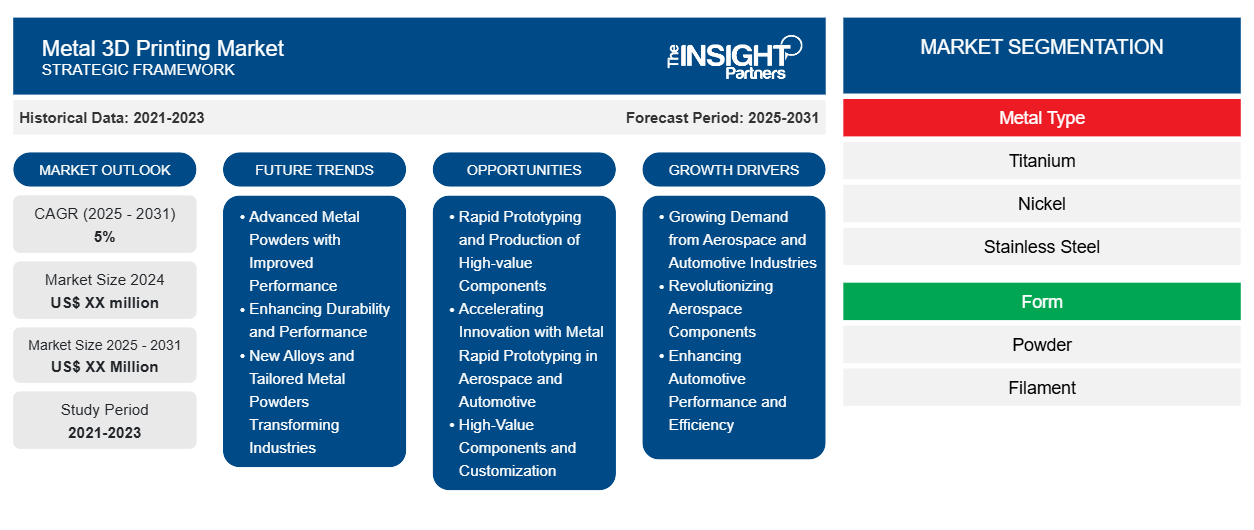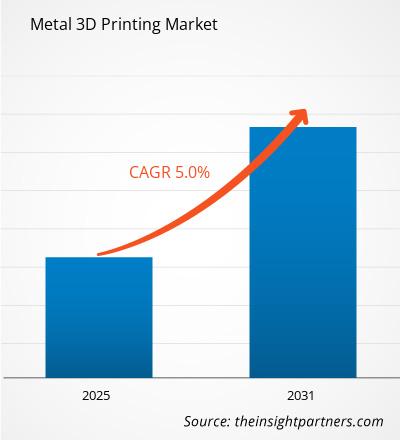Es wird erwartet, dass der Markt für 3D-Druck mit Metall von 2023 bis 2031 eine durchschnittliche jährliche Wachstumsrate (CAGR) von 5 % verzeichnet, wobei die Marktgröße von XX Millionen US-Dollar im Jahr 2023 auf XX Millionen US-Dollar im Jahr 2031 anwachsen wird.
Der Bericht ist nach Metallart (Titan, Nickel, Edelstahl, Aluminium und andere) segmentiert. Der Bericht präsentiert außerdem Analysen basierend auf der Form (Pulver, Filament und andere). Basierend auf der Endnutzung ist der Bericht segmentiert in (Luftfahrt und Verteidigung, Automobil, Medizin, Bauwesen und andere). Die globale Analyse ist weiter auf regionaler Ebene und in die wichtigsten Länder unterteilt. Der Bericht bietet den Wert in USD für die oben genannte Analyse und Segmente.
Zweck des Berichts
Der Bericht „Markt für 3D-Metalldruck“ von The Insight Partners soll die aktuelle Landschaft und das zukünftige Wachstum sowie die wichtigsten treibenden Faktoren, Herausforderungen und Chancen beschreiben. Dies wird verschiedenen Geschäftspartnern Einblicke geben, wie zum Beispiel:
- Technologieanbieter/-hersteller: Um die sich entwickelnde Marktdynamik zu verstehen und die potenziellen Wachstumschancen zu kennen, damit sie fundierte strategische Entscheidungen treffen können.
- Investoren: Durchführung einer umfassenden Trendanalyse hinsichtlich der Marktwachstumsrate, der finanziellen Marktprognosen und der Chancen entlang der Wertschöpfungskette.
- Regulierungsbehörden: Zur Regulierung von Richtlinien und Überwachungsaktivitäten auf dem Markt mit dem Ziel, Missbrauch zu minimieren, das Vertrauen der Anleger zu bewahren und die Integrität und Stabilität des Marktes aufrechtzuerhalten.
Marktsegmentierung für 3D-Metalldruck
Metallart
- Titan
- Nickel
- Edelstahl
- Aluminium
Bilden
- Pulver
- Filament
Endverbrauch
- Luft- und Raumfahrt und Verteidigung
- Automobilindustrie
- Medizin
- Konstruktion
Geographie
- Nordamerika
- Europa
- Asien-Pazifik
- Süd- und Mittelamerika
- Naher Osten und Afrika
Geographie
- Nordamerika
- Europa
- Asien-Pazifik
- Süd- und Mittelamerika
- Naher Osten und Afrika
Passen Sie diesen Bericht Ihren Anforderungen an
Sie erhalten kostenlos individuelle Anpassungen an jedem Bericht, einschließlich Teilen dieses Berichts oder einer Analyse auf Länderebene, eines Excel-Datenpakets sowie tolle Angebote und Rabatte für Start-ups und Universitäten.
- Holen Sie sich die wichtigsten Markttrends aus diesem Bericht.Dieses KOSTENLOSE Beispiel umfasst eine Datenanalyse von Markttrends bis hin zu Schätzungen und Prognosen.
Wachstumstreiber auf dem Markt für 3D-Metalldruck
- Wachsende Nachfrage aus der Luft- und Raumfahrtindustrie sowie der Automobilindustrie: Die Luft- und Raumfahrtindustrie sowie die Automobilindustrie sind die Hauptwachstumstreiber im Markt für Metall-3D-Druck für Lösungen zur Herstellung leichter und komplexer Teile. Die beiden Branchen konzentrieren sich auf Gewichtsreduzierung, um Kraftstoffverbrauch, Leistung und Emissionen zu verbessern. Der Metall-3D-Druck ermöglicht komplexe Designs bei reduziertem Gewicht.
- Revolutionierung von Luft- und Raumfahrtkomponenten: Der 3D-Druck von Metall hat die Spielregeln für Luft- und Raumfahrtkomponenten wie Turbinenschaufeln, Halterungen und andere Strukturkomponenten geändert. Konventionelle Fertigungsmethoden schränken das Design ein, aber die additive Fertigung nutzt komplexe Geometrien, die das Gewicht reduzieren können, normalerweise ohne Kompromisse bei der Festigkeit einzugehen. So hat die neue Methode dazu geführt, dass Flugzeuge besser funktionieren und noch effizienter werden, was wiederum das Marktwachstum ankurbelt.
- Verbesserung der Leistung und Effizienz von Automobilen: Ebenso setzt der Automobilsektor auf die Herstellung von leichten und leistungsstarken Komponenten durch 3D-Metalldruck. Die meisten von den Herstellern verwendeten Materialien wie Titan, Aluminium und Edelstahl ergeben sehr effiziente Teile, die langlebig, aber komplex gestaltet sind. Diese verbessern den Kraftstoffverbrauch und das Handling und erhöhen somit die Nachfrage nach 3D-Metalldrucktechnologien im Automobilbau.
Zukünftige Trends auf dem Markt für 3D-Metalldruck
- Fortschrittliche Metallpulver mit verbesserter Leistung: Leistungsstarke fortschrittliche Metallpulver sind einige der zukünftigen Trends, die das Wachstum des Marktes für 3D-Metalldruck vorantreiben. Solche Pulver verleihen noch bessere Eigenschaften wie Festigkeit, Hitzebeständigkeit und Korrosionsbeständigkeit. Solche fortschrittlichen Materialien werden für 3D-Druckanwendungen in Branchen, die Komponenten herstellen, die mehreren Einsatzbedingungen standhalten müssen und höhere Haltbarkeit und hohe Leistungsstandards erfordern, zunehmend notwendig.
- Verbesserte Haltbarkeit und Leistung: Fortschrittliche Metallpulver ermöglichen die Herstellung von Komponenten, die extremen Belastungen standhalten, wie sehr hohen Temperaturen und mechanischen Belastungen in Bereichen wie der Luft- und Raumfahrt und der Automobilindustrie. Sie ermöglichen den Druck leichterer, stabilerer Komponenten mit besseren Leistungsmerkmalen, die sich unmittelbar auf die Effizienz und Lebensdauer kritischer Teile in Motoren, Turbinen und Fahrzeugstrukturen auswirken; dies treibt auch das Wachstum auf dem Markt voran.
- Neue Legierungen und maßgeschneiderte Metallpulver verändern Branchen: Die Entwicklung neuer Legierungen und maßgeschneiderter Metallpulver treibt auch die Eiseninnovation in Branchen wie der Medizintechnik und dem Werkzeugbau voran. Diese „exotischen“ Materialien ermöglichen die Schaffung wirklich beispielloser komplexer Geometrien mit für bestimmte Anwendungen optimierten Eigenschaften – sofortige Biokompatibilität für Implantate – oder viel höhere Härte für Industriewerkzeuge. Je mehr Personalisierung und hohe Qualität von den Kunden gefordert werden, desto schneller oder stärker werden fortschrittliche Metallpulver im 3D-Druck eingesetzt.
Marktchancen für den 3D-Metalldruck
- Rapid Prototyping und Produktion hochwertiger Komponenten: Der Markt für 3D-Metalldruck wird durch Rapid Prototyping und die Herstellung hochwertiger Komponenten erheblich vorangetrieben. Die Prototypenproduktion verkürzt weiterhin Designtestzyklen, Entwicklungszeiten und Fertigungsprozesse in allen Branchen. Dies gilt insbesondere für die kritischen Bereiche Luft- und Raumfahrt, Automobilbau und Medizintechnik.
- Beschleunigung der Innovation mit Rapid Prototyping für Metalle in der Luft- und Raumfahrt sowie im Automobilbau: Sowohl in der Luft- und Raumfahrt als auch im Automobilbau ist Rapid Prototyping für Metalle von entscheidender Bedeutung für schnellere Innovationszyklen. Mit Rapid Prototypes können Ingenieure Designs schnell iterieren und durch Tests Anpassungen vornehmen, bevor die Markteinführungszeit verkürzt wird. Das Ergebnis ist eine beschleunigte Entwicklung, höhere Genauigkeit durch verbesserte Designs sowie leistungsfähigere und kostengünstigere Komponenten – alles zusammen führt zu einer erhöhten Nachfrage nach Technologien im Zusammenhang mit dem 3D-Metalldruck.
- Hochwertige Komponenten und Anpassung: Eine weitere treibende Kraft für das Wachstum dieses Marktes ist die Herstellung hochwertiger Komponenten für Turbinenschaufeln, Motorteile und ziemlich komplexe medizinische Implantate. Solche leistungsstarken und komplexen geometrischen Komponenten, die nur durch 3D-Metalldruck erreicht werden können, können mit herkömmlichen Konstruktionsmethoden nicht hergestellt werden. Hochgradig angepasste, starke, aber leichte Komponenten, die häufig spezielle Eigenschaften erfordern, haben in der Regel ihren Wert in den oben genannten Branchen.
Regionale Einblicke in den Markt für 3D-Metalldruck
Die regionalen Trends und Faktoren, die den Markt für 3D-Metalldruck im Prognosezeitraum beeinflussen, wurden von den Analysten von Insight Partners ausführlich erläutert. In diesem Abschnitt werden auch die Marktsegmente und die Geografie des 3D-Metalldrucks in Nordamerika, Europa, im asiatisch-pazifischen Raum, im Nahen Osten und Afrika sowie in Süd- und Mittelamerika erörtert.

- Holen Sie sich die regionalen Daten für den Markt für 3D-Metalldruck
Umfang des Marktberichts zum 3D-Druck von Metall
| Berichtsattribut | Details |
|---|---|
| Marktgröße im Jahr 2023 | XX Millionen US-Dollar |
| Marktgröße bis 2031 | XX Millionen US-Dollar |
| Globale CAGR (2023 - 2031) | 5 % |
| Historische Daten | 2021-2022 |
| Prognosezeitraum | 2024–2031 |
| Abgedeckte Segmente | Nach Metallart
|
| Abgedeckte Regionen und Länder | Nordamerika
|
| Marktführer und wichtige Unternehmensprofile |
|
Marktteilnehmerdichte im Metall-3D-Druck: Auswirkungen auf die Geschäftsdynamik verstehen
Der Markt für 3D-Druck auf Metall wächst rasant. Die Nachfrage der Endnutzer steigt aufgrund von Faktoren wie sich entwickelnden Verbraucherpräferenzen, technologischen Fortschritten und einem größeren Bewusstsein für die Vorteile des Produkts. Mit der steigenden Nachfrage erweitern Unternehmen ihr Angebot, entwickeln Innovationen, um die Bedürfnisse der Verbraucher zu erfüllen, und nutzen neue Trends, was das Marktwachstum weiter ankurbelt.
Die Marktteilnehmerdichte bezieht sich auf die Verteilung der Firmen oder Unternehmen, die in einem bestimmten Markt oder einer bestimmten Branche tätig sind. Sie gibt an, wie viele Wettbewerber (Marktteilnehmer) in einem bestimmten Marktraum im Verhältnis zu seiner Größe oder seinem gesamten Marktwert präsent sind.
Die wichtigsten auf dem Markt für 3D-Metalldruck tätigen Unternehmen sind:
- EOS
- Konzept Laser
- SLM Lösungen
- Renishaw
- Additive Industrien
- GE Additive
Haftungsausschluss : Die oben aufgeführten Unternehmen sind nicht in einer bestimmten Reihenfolge aufgeführt.

- Überblick über die wichtigsten Akteure auf dem Markt für 3D-Metalldruck
Wichtige Verkaufsargumente
- Umfassende Abdeckung: Der Bericht deckt die Analyse von Produkten, Dienstleistungen, Typen und Endbenutzern des Marktes für 3D-Metalldruck umfassend ab und bietet einen ganzheitlichen Überblick.
- Expertenanalyse: Der Bericht basiert auf dem umfassenden Verständnis von Branchenexperten und Analysten.
- Aktuelle Informationen: Der Bericht stellt durch die Abdeckung aktueller Informationen und Datentrends Geschäftsrelevanz sicher.
- Anpassungsoptionen: Dieser Bericht kann angepasst werden, um spezifische Kundenanforderungen zu erfüllen und die Geschäftsstrategien optimal anzupassen.
Der Forschungsbericht zum Markt für 3D-Metalldruck kann daher dabei helfen, die Branchensituation und Wachstumsaussichten zu entschlüsseln und zu verstehen. Obwohl es einige berechtigte Bedenken geben kann, überwiegen die allgemeinen Vorteile dieses Berichts tendenziell die Nachteile.
- Historische Analyse (2 Jahre), Basisjahr, Prognose (7 Jahre) mit CAGR
- PEST- und SWOT-Analyse
- Marktgröße Wert/Volumen – Global, Regional, Land
- Branche und Wettbewerbsumfeld
- Excel-Datensatz


- Adaptive Traffic Control System Market
- Joint Pain Injection Market
- Pressure Vessel Composite Materials Market
- Identity Verification Market
- Energy Recovery Ventilator Market
- 3D Mapping and Modelling Market
- Employment Screening Services Market
- Unit Heater Market
- Malaria Treatment Market
- Oxy-fuel Combustion Technology Market

Report Coverage
Revenue forecast, Company Analysis, Industry landscape, Growth factors, and Trends

Segment Covered
This text is related
to segments covered.

Regional Scope
North America, Europe, Asia Pacific, Middle East & Africa, South & Central America

Country Scope
This text is related
to country scope.
Häufig gestellte Fragen
Advanced Metal Powders with Improved Performance is expected to be the key market trends.
Based on geography, Asia Pacific held the largest share of the metal 3D printing market.
Based on metal type, aluminum is expected to witness the fastest growth during the forecast period
EOS, Concept Laser, SLM Solutions are some of the key players operating in the metal 3D printing market
Growing Demand from Aerospace and Automotive Industries is driving the market growth
The Metal 3D Printing Market is estimated to witness a CAGR of 5% from 2023 to 2031
Trends and growth analysis reports related to Chemicals and Materials : READ MORE..
The Insight Partners performs research in 4 major stages: Data Collection & Secondary Research, Primary Research, Data Analysis and Data Triangulation & Final Review.
- Data Collection and Secondary Research:
As a market research and consulting firm operating from a decade, we have published and advised several client across the globe. First step for any study will start with an assessment of currently available data and insights from existing reports. Further, historical and current market information is collected from Investor Presentations, Annual Reports, SEC Filings, etc., and other information related to company’s performance and market positioning are gathered from Paid Databases (Factiva, Hoovers, and Reuters) and various other publications available in public domain.
Several associations trade associates, technical forums, institutes, societies and organization are accessed to gain technical as well as market related insights through their publications such as research papers, blogs and press releases related to the studies are referred to get cues about the market. Further, white papers, journals, magazines, and other news articles published in last 3 years are scrutinized and analyzed to understand the current market trends.
- Primary Research:
The primarily interview analysis comprise of data obtained from industry participants interview and answers to survey questions gathered by in-house primary team.
For primary research, interviews are conducted with industry experts/CEOs/Marketing Managers/VPs/Subject Matter Experts from both demand and supply side to get a 360-degree view of the market. The primary team conducts several interviews based on the complexity of the markets to understand the various market trends and dynamics which makes research more credible and precise.
A typical research interview fulfils the following functions:
- Provides first-hand information on the market size, market trends, growth trends, competitive landscape, and outlook
- Validates and strengthens in-house secondary research findings
- Develops the analysis team’s expertise and market understanding
Primary research involves email interactions and telephone interviews for each market, category, segment, and sub-segment across geographies. The participants who typically take part in such a process include, but are not limited to:
- Industry participants: VPs, business development managers, market intelligence managers and national sales managers
- Outside experts: Valuation experts, research analysts and key opinion leaders specializing in the electronics and semiconductor industry.
Below is the breakup of our primary respondents by company, designation, and region:

Once we receive the confirmation from primary research sources or primary respondents, we finalize the base year market estimation and forecast the data as per the macroeconomic and microeconomic factors assessed during data collection.
- Data Analysis:
Once data is validated through both secondary as well as primary respondents, we finalize the market estimations by hypothesis formulation and factor analysis at regional and country level.
- Macro-Economic Factor Analysis:
We analyse macroeconomic indicators such the gross domestic product (GDP), increase in the demand for goods and services across industries, technological advancement, regional economic growth, governmental policies, the influence of COVID-19, PEST analysis, and other aspects. This analysis aids in setting benchmarks for various nations/regions and approximating market splits. Additionally, the general trend of the aforementioned components aid in determining the market's development possibilities.
- Country Level Data:
Various factors that are especially aligned to the country are taken into account to determine the market size for a certain area and country, including the presence of vendors, such as headquarters and offices, the country's GDP, demand patterns, and industry growth. To comprehend the market dynamics for the nation, a number of growth variables, inhibitors, application areas, and current market trends are researched. The aforementioned elements aid in determining the country's overall market's growth potential.
- Company Profile:
The “Table of Contents” is formulated by listing and analyzing more than 25 - 30 companies operating in the market ecosystem across geographies. However, we profile only 10 companies as a standard practice in our syndicate reports. These 10 companies comprise leading, emerging, and regional players. Nonetheless, our analysis is not restricted to the 10 listed companies, we also analyze other companies present in the market to develop a holistic view and understand the prevailing trends. The “Company Profiles” section in the report covers key facts, business description, products & services, financial information, SWOT analysis, and key developments. The financial information presented is extracted from the annual reports and official documents of the publicly listed companies. Upon collecting the information for the sections of respective companies, we verify them via various primary sources and then compile the data in respective company profiles. The company level information helps us in deriving the base number as well as in forecasting the market size.
- Developing Base Number:
Aggregation of sales statistics (2020-2022) and macro-economic factor, and other secondary and primary research insights are utilized to arrive at base number and related market shares for 2022. The data gaps are identified in this step and relevant market data is analyzed, collected from paid primary interviews or databases. On finalizing the base year market size, forecasts are developed on the basis of macro-economic, industry and market growth factors and company level analysis.
- Data Triangulation and Final Review:
The market findings and base year market size calculations are validated from supply as well as demand side. Demand side validations are based on macro-economic factor analysis and benchmarks for respective regions and countries. In case of supply side validations, revenues of major companies are estimated (in case not available) based on industry benchmark, approximate number of employees, product portfolio, and primary interviews revenues are gathered. Further revenue from target product/service segment is assessed to avoid overshooting of market statistics. In case of heavy deviations between supply and demand side values, all thes steps are repeated to achieve synchronization.
We follow an iterative model, wherein we share our research findings with Subject Matter Experts (SME’s) and Key Opinion Leaders (KOLs) until consensus view of the market is not formulated – this model negates any drastic deviation in the opinions of experts. Only validated and universally acceptable research findings are quoted in our reports.
We have important check points that we use to validate our research findings – which we call – data triangulation, where we validate the information, we generate from secondary sources with primary interviews and then we re-validate with our internal data bases and Subject matter experts. This comprehensive model enables us to deliver high quality, reliable data in shortest possible time.


 Holen Sie sich ein kostenloses Muster für diesen Bericht
Holen Sie sich ein kostenloses Muster für diesen Bericht